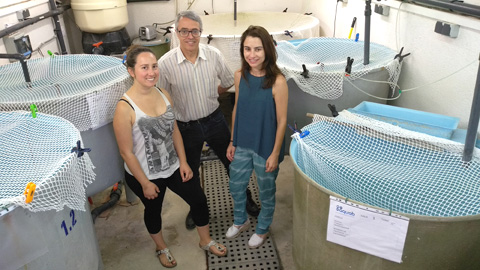First-Time Observation of Genetic and Physiological Damage Caused by Nanoplastics in Mussels

25/07/2018
Plastic pollution is a worldwide environmental problem which worsens when this material degrades into smaller-sized particles such as microplastics and nanoplastics, the latter capable of penetrating into an organism's cells.
A research team from the UAB Department of Cell Biology, Physiology and Immunology, the University of Aveiro and the Centro Interdisciplinar de Investigação Marinha e Ambiental (CIIMAR), Portugal, observed how some of these nanoplastics, despite existing in low concentrations, caused damage to the DNA, to the cell membranes and produce oxidative stress in the Mytilus galloprovincialis mussel, the most common Mediterranean mussel consumed by humans.
Researchers exposed the mussels, which originated from the Portuguese coast, to the presence of polystyrene nanoplastics during four days, in concentrations ranging from 0.005 milligrams per litre up to 50 milligrams per litre, and detected variations in the expression of several genes in the gills and digestive glands. With a concentration of only 0.05 mg per litre (mg/L) changes could be observed in the expression of these genes. This concentration modified the activity of the cat (cathepsin) gene, related to the correct functioning of the immune system in the mussel's gills. With 0.5 mg/L of nanoplastics, the cyp11 gene - related to the biotransformation of chemical substances for the correct functioning of the organism - also expressed itself in excess in the gills. And with 5 mg/L, the expression of both the cyp32 gene, related to biotransformation, and the lys gene, related to the immune system, was affected. Higher concentrations (50 mg/L) modified the expression of the hsp70 gene, related to cell-tissue repair, in the digestive glands of mussels.
Researchers also were able to observe how nanoplastics can heighten the toxic effects of other contaminants. Among the most common contaminants absorbed by nanoplastics is carbamazepine, a drug that treats seizure disorders. Adding small concentrations (6.3 micrograms per litre) of this drug to the presence of nanoplastics created an increase in absorption when compared to the drug by itself. The combination of carbamazepine with only 0.05 mg/L of nanoplastics modified the expression of tumour suppressor p53, related to DNA damage repair, in addition to the expression of the aforementioned genes cyp32, hsp70 and lys.
Researchers also observed the physiological effects of nanoplastics starting with only 0.005 mg/L. At this level of concentration the nanoplastics already produced alterations in the activity of the gill's alanine transaminase (ALT), while with 0.05 mg/L damage could be seen in the DNA of the haemolymph (the “blood” of molluscs), in cell membranes, and alterations in the biochemical indicators related to oxidative stress both in gills and in the digestive glands.
“All of these effects caused by nanoplastics take place at low concentrations, and it is therefore important to study the effects of these new contaminants at higher concentrations”, states Irene Brandts, first author of the research, which is the result of her PhD thesis at the UAB Department of Cell Biology, Physiology and Immunology.
Mariana Teles, UAB researcher in charge of the study and researcher also at the University of Aveiro and CIIMAR, highlights the importance of this type of damage in animals, given that “in contrast to the immediate effect of conventional plastic, which for example can kill a turtle if ingested, nanoplastics have a sub-lethal effect, with more long-term consequences”.
With regard to the possible effects of consuming mussels, the most common seafood consumed in Spain, “the research does not contain implications for human health, since there is no evidence that the molecular responses observed in these organisms can pass on to humans when consumed”, explains UAB professor Lluís Tort, co-author of the study.
The research was published in the latest edition of the journal Science of the Total Environment.
Original article:
I. Brandts, M. Teles, A.P. Gonçalves, A. Barreto, L. Franco-Martinez, A. Tvarijonaviciute, Effects of nanoplastics on Mytilus galloprovincialis after individual and combined exposure with carbamazepine. Science of the Total Environment 643 (2018) 775–784. https://doi.org/10.1016/j.scitotenv.2018.06.257